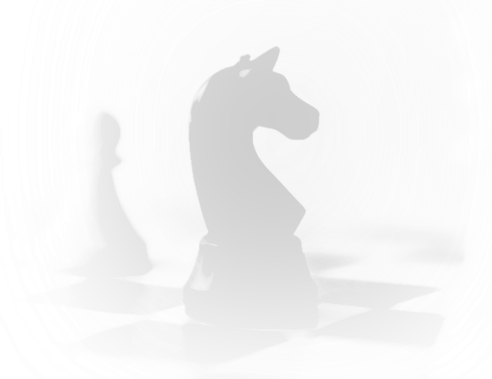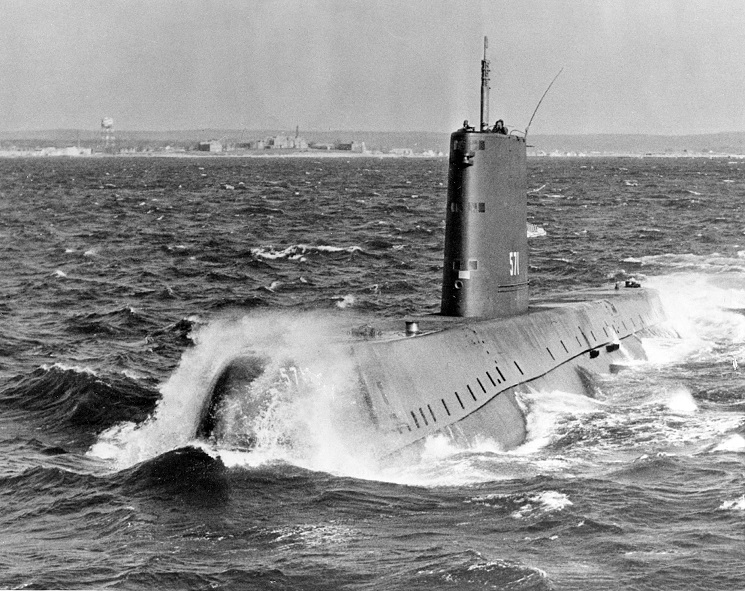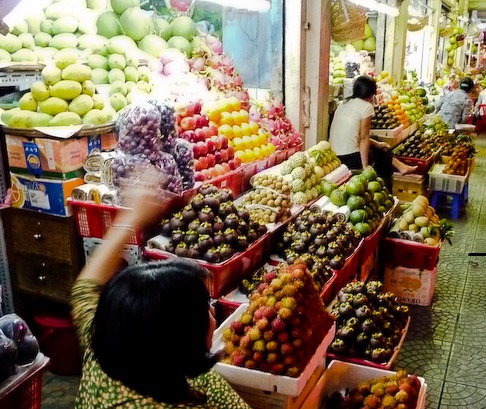
When most people think of nuclear technology, they think of nuclear weapons and electricity generation. They might be surprised to learn that nuclear technology also has applications in industry, such as in promoting growth and resilience of important crops, sterilising everyday items like eyedroppers, and diagnosing technical problems in industrial equipment without disrupting production. The continued access to these techniques is contingent on the ability of countries to apply nuclear technology safely and securely, a need that the International Atomic Energy Agency (IAEA) helps to actively address.
On 12 May 2021, the VCDNP, in collaboration with the German government, held a virtual workshop to discuss the sustainable use of nuclear technology in industrial applications and food safety, commensurate nuclear security measures, and the assistance provided by the IAEA in this regard. The workshop attracted diplomats, international civil servants, regulatory authorities, atomic energy authorities, and academic institutions from 30 IAEA Member States.
The panellists were:
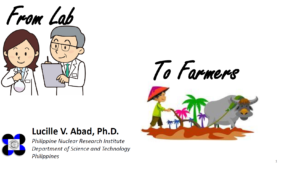
During her remarks, Dr. Abad discussed her work in the development and commercialisation of the Carrageenan Plant Growth Promoter, a unique product that is used as a plant food supplement to enhance rice growth in the Philippines. Carrageenan is a type of seaweed abundant in the Philippines. When treated with ionising radiation, the plant mass of carrageenan is broken down more finely than normal allowing it to enter the target plant’s stomata – tiny openings or pores in the plant tissue – to promote plant growth. When the final product is sprayed onto rice crops as a liquid, Dr. Abad’s research shows at least a 20 percent increase in crop yield protection against tungrovirus, as well as strengthened plant stems that make the plants more resistant to typhoons. The IAEA provided regulatory assistance and technical support for the development of the product.
A cobalt-60 multipurpose irradiator was used to develop the product but for the commercialisation of the product an electron beam (e-beam) accelerator is used as it can irradiate larger volumes. The e-beam throughput is much higher than gamma irradiation when irradiating a liquid.
Dr. Abad emphasised that a key factor in the successful adoption and commercialisation of the product was the field work conducted by the PNRI, familiarising farmers with the product and promoting the benefits and the safety thereof.
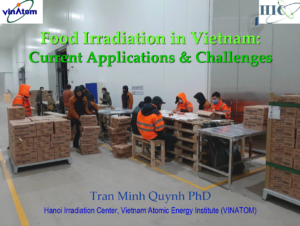
Dr. Tran began his remarks by noting that in Vietnam irradiation is used to delay the maturation of fresh fruits and vegetables thereby extending their shelf life. It is also used to disinfect grains such as millet, rice and coffee, and for the pasteurization and decontamination of frozen and dried seafood. Dr. Tran explained how irradiation kills microorganisms that may spoil food, such as bacteria or fungi. Low-level radiation also prevents insects from being able to reproduce. Ensuring produce is free of certain pests through phytosanitary treatment is a prerequisite for global trade, especially in the fresh fruits and vegetables market. The detection of an insect, such as a fruit fly, in a produce container can lead to immediate import bans and have devastating financial consequences for Vietnam.
Other treatment methods include fumigation with chemicals, which may leave residues that are harmful to people and the environment. Gamma irradiation as well as e-beams or x-rays can treat a large batch of food without loss in quality and with no risk to the consumer. Vietnam has several gamma radiation and e-beam facilities which are used for this purpose. Food irradiation was first introduced in Vietnam in 1999 with the help of the IAEA and the Food and Agriculture Organization of the United Nations (FAO) and their support continues today.
Among the challenges facing Vietnam, as noted by Dr. Tran, are those related to replacing depleted gamma sources. Although e-beam processing is much quicker than gamma, the latter is required when processing bulky products since the depth of penetration provided by e-beams is not sufficient for bulk materials. Gamma sources are becoming more expensive and harder to come by due to security concerns related to the shipment and use of these sources. While e-beams have none of the security concerns related to gamma radiation, it requires a high and stable electricity supply, is difficult to maintain and requires spare parts that are not readily available leading to longer downtimes. These are challenges commonly experienced by many developing countries explains Dr. Tran.
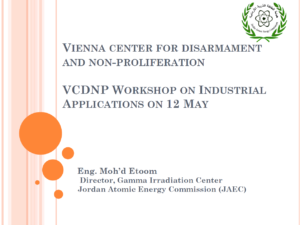
In his remarks, Mr. Etoom discussed the application of nuclear technology in sterilising a wide variety of goods, particularly in the medical field. He noted that Jordan, a country with a growing medical industry, is one of the main regional exporters of products like empty eye droppers and kidney washing equipment, both sterilised with ionising radiation.
Jordan began using gamma radiation to sterilise these and similar products because the previous use of ethylene oxide – a chemical commonly used as a sterilisation agent and which leaves a residue – can be fatal to people with enhanced sensitivity to this chemical. An IAEA technical cooperation project supported Jordan in the purchase of a large-scale cobalt-60 gamma irradiator to this end.
JAEC employs the highest standards of security to protect its radioactive sources. Mr. Etoom explained the various measures used, which include walls, fences roadblocks and cameras outside the building, restricted access to the building itself, and enhanced security equipment in sensitive areas such as motion sensors and radiation monitors. Regardless of the lengths to which the JAEC goes to secure these sources, Jordan, like Vietnam, is finding that these sources are becoming increasingly more expensive and harder to come by due to security challenges related to the shipment and use of these sources. Security concerns in the region further complicate the financing and transportation of the sources. To overcome these challenges, the JAEC has partnered with a private company that sterilises the empty eyedroppers and finances the replacement of the depleted cobalt sources that remain in the ownership of the JAEC.
When asked whether the JAEC is considering converting from gamma radiation to e-beam technology to avoid the challenges related to the use of cobalt-60 sources, Mr. Etoom explained that this option will be explored in the coming years. They are in the process of purchasing new cobalt sources which will give them at least five years to explore their options. Converting to the use of e-beams would require either converting their current gamma radiation facility or building a new e-beam facility. There is also an old e-beam facility that could be refurbished.
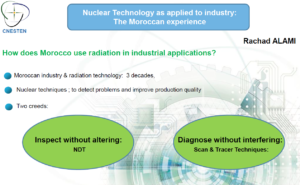
Dr. Alami gave an overview of how Morocco has used nuclear technology to bolster its industrial complex through non-destructive testing (NDT) techniques and how it is helping regional partners to benefit from these techniques. NDT enables a country to maintain stringent quality control standards for the safe operation of nuclear and other industrial installations. These techniques are used to perform analyses or inspections without altering the content of the inspected item. NDT also allows experts to diagnose technical problems without interrupting production using gamma scanning.
As gamma radiation is used, strong nuclear safety and security measures are paramount especially since the equipment has to be transported to and used in an industrial complex. To this end CNESTEN strictly adheres to the guidance provided by the IAEA’s Nuclear Security Series, and complies with the IAEA’s safety regulations during the transportation and use of the gamma radiation equipment. .
As an official IAEA Collaborating Centre, CNESTEN provides support to African countries, under an agreement between the IAEA and the African Regional Cooperative Agreement for Research, Development and Training related to Nuclear Science and Technology (AFRA), to implement these techniques in their local industries. Under the AFRA programme Morocco cooperates directly with countries such as Angola, Cameroon, Egypt, Kenya and Senegal. The IAEA works with countries like Morocco to promote the peaceful uses of radiation technologies in industry, with the aim of having an immediate impact on these countries’ economies.
Industrial applications of nuclear technology are various in scope and sector, but all the speakers noted the importance of adhering to the IAEA’s security guidance to protect radioactive sources from theft and misuse in order to ensure the sustainable use of this technology. These countries also have measures in place to detect and respond to malicious acts involving nuclear or other radioactive material.
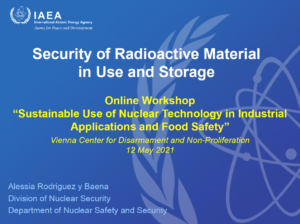
In this regard, Dr. Rodriguez y Baena provided and overview of IAEA’s work in assisting States, upon request, to enhance the security of radioactive material in use and storage under the IAEA’s programme on nuclear security. This assistance includes the development and publication of the IAEA Nuclear Security Series guidance documents and online Nuclear Security E-Learning | IAEA, conduct of face-to-face practical training on various topics (e.g., First Bilingual Regional Course on Security of Radioactive Material Held in Russia | IAEA), provision of expert guidance through peer review missions and advisory services such as the International Physical Protection Advisory Service (IPPAS) | IAEA, as well as delivery of technical assistance to support countries in meeting the provision of relevant international instruments like the Code of Conduct on the Safety and Security of Radioactive Sources (CoC) and its supplementary Guidance. IAEA’s Division of Nuclear Security (NSNS) also provides a technical backstop for nuclear security aspects of relevant IAEA initiatives, including projects under the IAEA Technical Cooperation programme. NSNS also works closely with the Division of Radiation, Transport and Waste Safety (NSRW), and other organisational units of the IAEA, to implement joint activities aimed at supporting States’ in the safe and secure application of nuclear technology such as Regulatory Infrastructure Development Projects (RIDP), and to promote dialogue on the same, for instance by organising the upcoming International Conference on the Safety and Security of Radioactive Sources, planned to be held in Vienna on 20-24 June 2022.
Dr. Rodriguez y Baena emphasised that nuclear security is a national responsibility, while the IAEA has a central role in strengthening the nuclear security framework globally and in coordinating international activities in the field of nuclear security, including by supporting States, upon request, to establish and maintain an effective nuclear security regime. She also noted that the selection of using one technology or the other for a given application is the prerogative of each country.
During the discussion Dr. Alami and Dr. Abad were asked whether they were experiencing similar challenges to Vietnam and Jordan with the replacement of radioactive sources. Both noted that they had not encountered any difficulties to date. The Philippines is receiving its sources from Canada and a return agreement for the sources is to be negotiated. Morocco receives its sources from many suppliers such as India, Belgium and France. Dr. Rodriguez y Baena noted that, when the IAEA provides radioactive sources to Member States through its Technical Cooperation Programme, a return to supplier clause is included in the contract. She noted that this return to supplier is among the management options described in the IAEA Guidance on the Management of Disused Radioactive Sources supplementary to the CoC.
When asked how to ensure that countries using source-based technology have the proper safety and security infrastructure in place, Dr. Alami noted again the support provided by the IAEA, in particular the expert missions. Dr. Rodriguez y Baena added that the IAEA’s Department of Nuclear Safety and Security stands ready to support States, upon request, in enhancing the safe and secure use of radioactive sources for peaceful uses throughout their lifecycle.
The speakers also emphasised the importance of raising awareness and educating people about the benefits of radiation. In terms of using irradiation for food safety, customer acceptance is important and public education is required to convince consumers that irradiated food is safe for consumption. In this regard, the salience of dialogue on the interplay between nuclear security and the peaceful uses of nuclear science and technology.
Featured image courtesy of Quevenco/IAEA
